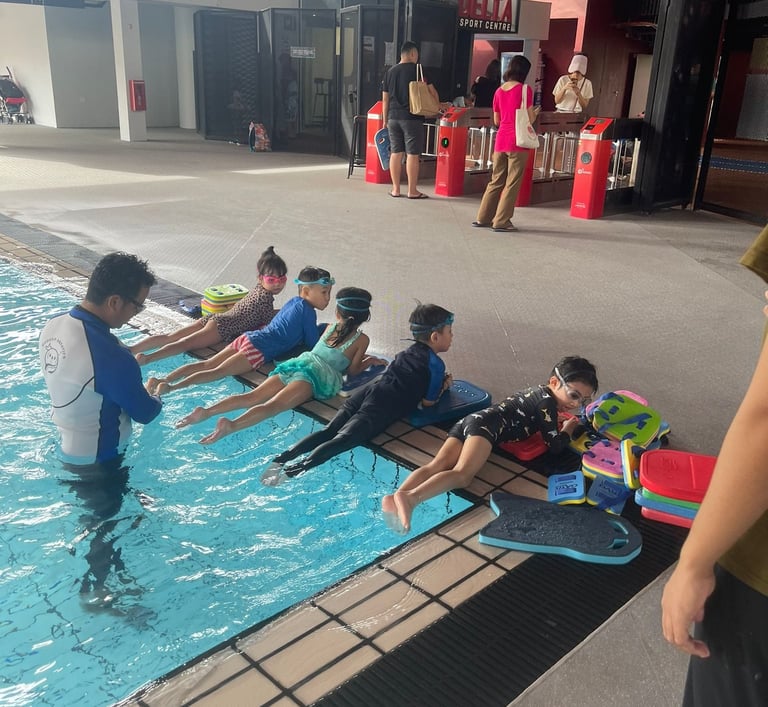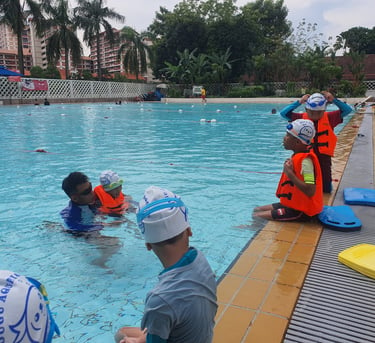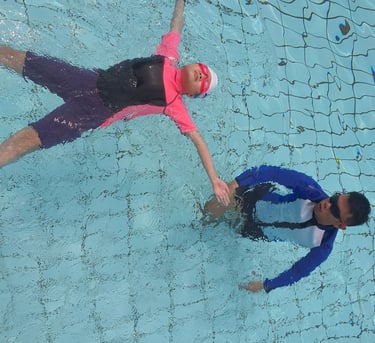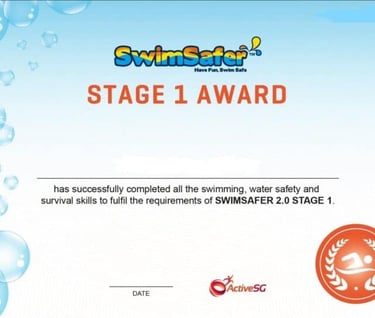Swimsafer Stage 1: Essential Singapore Swimming Lessons
The objective is develop confidence and independence in the water, learn general and deep-end water safety. Techniques taught include the forward and backward movement, safe entry and exit and personal water safety.


SwimSafer Stage 1 Test Criteria
Entries & Exits
Slide-in entry.
Exit using ladder and from pool edge.
Sculling & Body Orientation
Front float (mushroom or jellyfish), 5 sec, recover to standing position.
Back float, 5 sec, recover to a standing position.
Underwater Skills
Submerge in waist deep (student’s) water, open eyes and blow bubbles.
Movement / Swimming / Strokes
Movement on front 10m. (alternating arms & legs and/or simultaneous arms and legs)
Movement on back 5m. (alternating arms & legs and/or simultaneous arms and legs)
Survival & Activity Skills
Signal distress.
Grasp a flotation aid and float for 10 sec.
Move to the pool’s edge (with the float).
Exit safely from water.
Dressed in swimwear, shorts and t-shirt demonstrate:
Correctly fit a PFD, jump into the water, float for 30 seconds and then climb out of deep water.
Knowledge
Principles of Personal Safety and Survival.
Environmental Awareness.
Health Awareness.
Emergency Situations and Survival Techniques.
Rescues.
Our 24 Week Lesson Plan to Pass SwimSafer Stage 1
Week 1-4: Water Introduction and Safety Skills
Week 1:
Water entry and exit practice: The coach will teach children how to safely enter and exit the water using the poolside or ladder. They will emphasize the importance of caution and balance while entering and exiting the pool.
Buoyancy and floatation skills: Children will be introduced to the concept of buoyancy and given flotation aids to support them in the water. The coach will guide them in maintaining a relaxed and comfortable float on the front and back, gradually increasing the duration.
Breath control and submersion: The coach will engage children in activities that involve blowing bubbles through the mouth and nose while submerged in waist-deep water. They will encourage children to open their eyes underwater and build comfort in this aspect.
Week 2:
Front float: The coach will focus on teaching children the front float technique, such as the mushroom or jellyfish float. They will instruct children to extend their arms and legs, relax their bodies, and maintain a stable floating position for a duration of 5 seconds. The coach will provide support and guidance as needed.
Back float: Children will practice the back float, learning to relax their bodies, keep their faces out of the water, and maintain a stable floating position for 5 seconds. The coach will provide necessary support to help children feel secure during this activity.
Underwater skills: The coach will guide children in submerging their heads underwater, opening their eyes, and blowing bubbles. This activity aims to familiarize children with the sensation of being submerged and build confidence in the water.
Week 3:
Water movement on the front: Children will learn basic water movement on the front using alternating arm and leg actions. The coach will demonstrate and guide them in moving forward through the water, emphasizing proper body position, coordination, and the importance of rhythmic movements.
Water movement on the back: The coach will introduce water movement on the back, teaching children alternating arm and leg actions for backward propulsion. They will focus on maintaining a horizontal body position and developing coordination in their movements.
Signal distress: Children will be taught how to signal distress in the water, such as raising an arm or waving for assistance. The coach will emphasize the importance of alerting lifeguards or instructors in case of an emergency.
Week 4:
Grasping a flotation aid and floating: Children will practice grasping a flotation aid, such as a kickboard or pool noodle, and floating with it for a duration of 10 seconds. The coach will encourage relaxation and balance during this activity and assist children in maintaining their position.
Moving to the pool's edge: Children will learn how to move to the pool's edge while holding onto a flotation aid. The coach will guide them in using proper kicking and arm movements to reach the pool's edge safely.
Safe exit from the water: The coach will demonstrate and teach children how to exit the water safely using the ladder or poolside. They will emphasize the importance of caution and balance during the exit process.
Throughout these weeks, the coach will also introduce water safety knowledge, including basic rules, pool boundaries, and the importance of listening to lifeguards or swimming instructors. The focus will be on creating a safe and enjoyable learning environment for the children...
Our classes are conducted at Bishan Swimming Complex and Delta Swimming Complex. Drop us a text to find out more...








